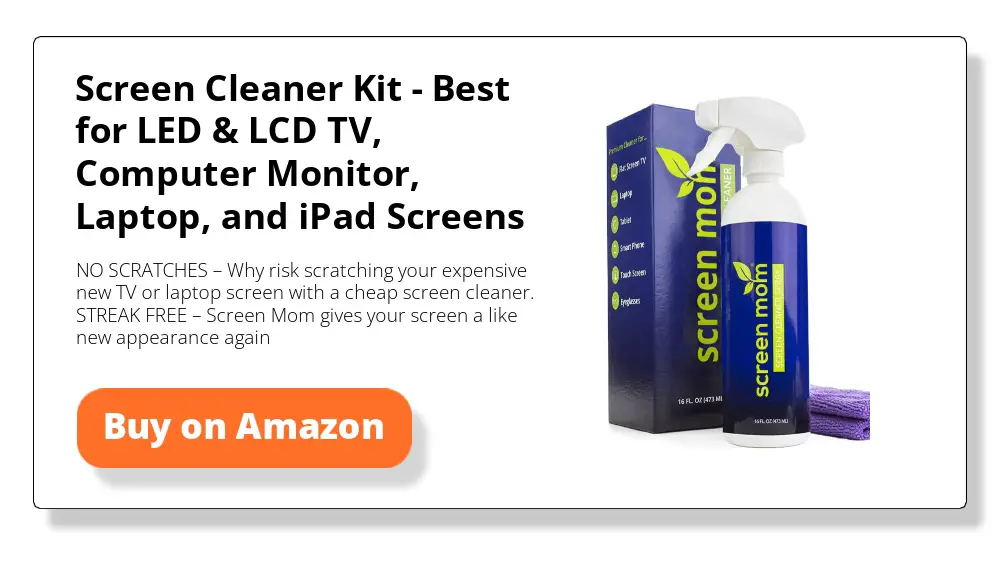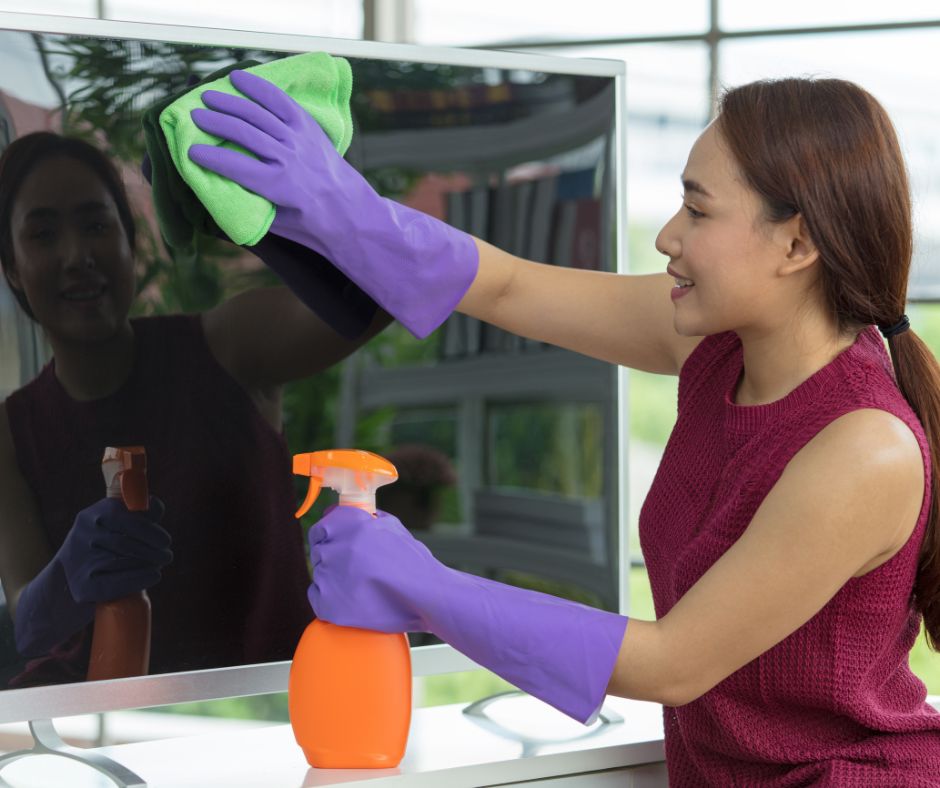Last Updated on October 29, 2024 by Team Ideas24
It goes without saying that we now live our lives mostly through our TVs. And keeping your TV screen clean has become equally crucial as more people remain indoors and binge-watch their favourite programs or streaming flicks.
Regretfully, many times people forget to do this chore, and a filthy screen can seriously impair viewing quality. Our TV displays are continually exposed to sources of filth that affect picture quality, from fingerprints to dust, dirt and grime.

Contents [show]
Pristine in No Time: The Ultimate TV Screen Cleaner Guide
By following these steps, you can achieve a smudge-free TV screen and enjoy a clear, sharp picture. It’s recommended to clean your TV screen once a week to prevent buildup and maintain its quality.

The Use of Proper TV Screen Cleaner
The improper cleaning solution can break your TV screen. And it could be difficult to determine which is safe and efficient among the many possibilities.
This article will guide you through a TV screen cleaner, helping you achieve a crystal-clear picture every time you tune in to your favorite shows. Covering all screen types, including flat-screen, LCD, LED, and plasma, it ensures you know the correct methods to keep every screen in your home spotless and safe from harm.

In addition to removing dust and grime, this TV screen cleaner can remove fingerprints and other stains. A soft, non-abrasive cleaning method is essential for protecting screens from scratches, and the right cleaning solution can make all the difference.
Keep the screen clean to make your TV last longer and enjoy clear, uninterrupted watching.
Avoiding Harsh Chemicals While Cleaning
While some cleaning solutions are effective at removing dirt and grime from the screen, they probably contain harsh chemicals that can cause also damage. It’s important to avoid such harsh chemicals as they will probably not only cause damage to the screen but can also pose a risk to your health.
Instead, opt for a TV screen cleaner that is free of toxins and other harmful chemicals. This way, you can be assured that the product is safe for use on your TV screen and will not have any adverse effects on your health.
By using a non-toxic and safe TV screen cleaner, you can keep your screens clean and clear without putting yourself or your other expensive appliances at risk.
Cleaning TV Screen With Distilled Water and Vinegar
The safest TV screen cleaner is distilled water. Distilled water is a gentle and effective cleaning solution that can be used to clean a TV screen without the risk of damaging it. Distilled water is free of minerals and other impurities, so it will not leave any residue on the screen.
When using distilled water as your TV screen cleaner, it’s important to use a soft microfiber cloth to wipe the screen gently in a circular motion. Make sure to avoid pressing too hard, as this can damage the screen.
You can make a simple and effective DIY TV screen cleaner at home using white vinegar and water. It’s a simple process!
Materials:
- White vinegar
- Distilled water
- Spray bottle
- Microfiber cloth
Instructions:
- Prepare the Cleaning Solution:
- Mix equal parts distilled water and isopropyl alcohol (or substitute with white vinegar if preferred). For example, combine 1/4 cup of each in a spray bottle.
- Avoid using tap water, as it can leave streaks or mineral deposits on the screen.
- Turn Off and Unplug the TV:
- Cleaning a cool, powered-off screen prevents streaking and protects the electronics inside.
- Dust the Screen:
- Use a dry microfiber cloth to gently dust the surface and remove any loose particles.
- Apply the Cleaner to the Cloth, Not Screen:
- Lightly spray the cleaning solution onto a microfiber cloth (never directly onto the screen to avoid excess moisture).
- Wring out the cloth if it feels too damp.
- Clean the Screen:
- Gently wipe the screen in an “S” or circular pattern, starting from the top. This technique reduces streaking.
- Focus on smudged or sticky spots, applying light pressure only as needed.
- Buff and Dry:
- Use a second dry microfiber cloth to gently buff and dry the screen, ensuring no moisture remains.
Note: You should test the TV screen cleaner on a small, inconspicuous area of the screen before using it to clean the entire surface. This will help you ensure that the solution does not cause any damage to the screen.
For tougher smudges, consider adding a drop of mild dish soap to the mixture (only if recommended for your screen type). This method works across various screen types, including LCD and LED, and avoids the need for commercial cleaners that can leave streaks or damage the screen over time
How to Clean a Remote Control Safely and Effectively
Aside from cleaning the TV screen with a TV screen cleaner, cleaning the remote control is essential to maintain its functionality and hygiene. Follow these steps to ensure a thorough and safe cleaning process:
- Prepare for Cleaning
- Remove the Batteries Start by removing the batteries to avoid any risk of electrical damage.
- Initial Debris Removal
- Dislodge Loose Particles: Turn the remote control upside down, with the buttons facing downward. Gently tap it against your palm to shake out any loose crumbs or dust trapped between the buttons.
- Wipe Down the Surface
- Use a Soft Cloth: Lightly dampen a soft cloth with a small amount of alcohol diluted in water. The solution should be minimal to avoid soaking.
- Wipe the Remote: Carefully wipe the entire surface of the remote. Ensure that the cloth is not too wet to prevent internal damage.
- Clean Between the Buttons
- Cotton Swab Magic: For spaces around and between the buttons, use a cotton swab moistened with the diluted alcohol solution. This helps in reaching tight spots.
- Tackling Stubborn Dirt: If you encounter debris that’s deeply lodged, gently use a dry toothbrush or a toothpick to extract it.
- Final Touch
- Dry Off the Remote: Once clean, gently wipe the remote again with a dry, soft cloth to absorb any remaining moisture.
- Reassemble
- Reinsert Batteries: Once satisfied that the remote is fully dry, reinstate the batteries and test the remote to ensure it’s working perfectly.
By following these steps, you can maintain a clean and effective remote control, prolonging its lifespan and ensuring peak performance.
You can also invest your time in creating your own DIY disinfectant wipes at home. It’s best to go for cost-efficient and eco-friendly DIY cleaning tools.

Clean Your TV Screen Regularly
When it comes to cleaning your TV screen, it’s essential to follow the manufacturer’s guidelines for cleaning and product usage. But how often should you clean your TV screen? Well, it depends on several factors such as usage frequency, humidity, and dust accumulation in the surrounding environment. In general, experts recommend cleaning your TV screen at least once a week or as needed.
Using a specially designed TV screen cleaning solution can effectively remove smudges, fingerprints, and other debris without causing damage to the TV screen.
Is it Necessary to Buy a TV Cleaning Kit?
Some cleaning kits can set you back $15 to $20, and often, they include just a microfiber cloth and a small bottle of cleaning solution—likely composed mostly of water. This makes them less cost-effective, especially when you can purchase microfiber cloths separately at an office supply store or online for a fraction of the price. If you do opt for a kit, it’s crucial to ensure it doesn’t contain any harmful chemicals that could harm your screen.
Fortunately, all you need is some vinegar and distilled water to whip up a homemade screen cleaner for your TV. By creating your own cleaning solution, you not only save money but also avoid the potential risks associated with chemical-laden store-bought options. This DIY method ensures your TV screen remains pristine without the unnecessary expense.
Wrapping It Up
To wrap up, keeping your TV screen clean is essential to maintain its picture quality and prolong its lifespan. A dirty screen can cause glare, reduce image clarity, and even damage the screen.
Finding the right TV screen cleaner can make a significant difference. While there are many TV screen cleaning solutions available in the market, some can be costly and contain harmful chemicals that can damage your screen.
Fortunately, all you need is some vinegar and distilled water to whip up a homemade screen cleaner for your TV. Vinegar is a powerful natural cleanser that can eliminate filth, grime, and fingerprints, and distilled water is devoid of contaminants and minerals that could damage your screen.
You can easily find and purchase highly pure distilled water at most supermarket stores. On the flip side, vinegar is probably already in your kitchen and is a natural cleaner that works wonders on even the most entrenched stains. You have easy access to a solution that cleans TV screens effectively and safely.
Are you giving this TV screen cleaning solution a try?




















